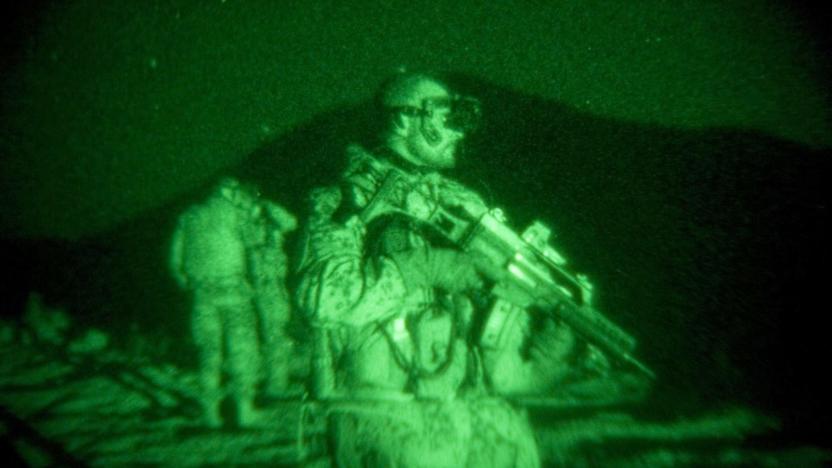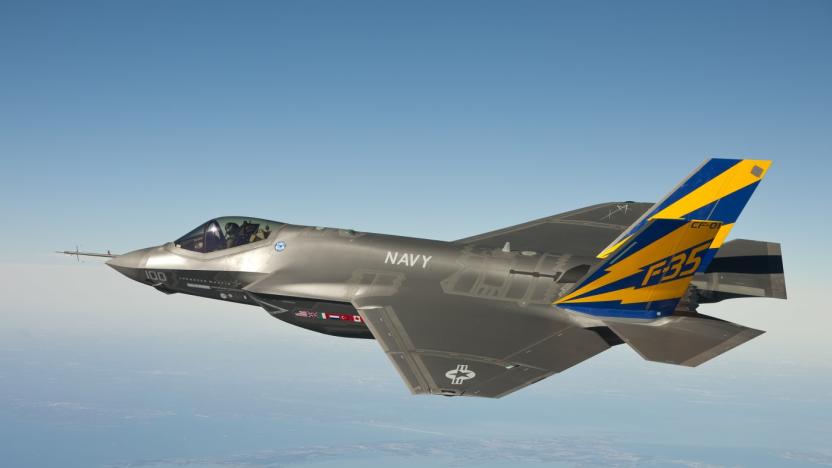war
Latest

DJI grounded its drones in Iraq and Syria to lock out extremists
The most recognizable name in drones has reportedly stepped in to help the United States in its ongoing war on terror. As The Register reports today, Shenzhen-based DJI -- makers of the ever-popular Phantom and Inspire series quadcopters -- quietly created software-based no-fly zones over large parts of Iraq and Syria where ISIS fighters have been known to strap improvised bombs to commercial drones.

ICYMI: DARPA's drone snatcher and Pokémon: Minecraft edition
Today on In Case You Missed It: DARPA unveiled a UAV recovery systems that can catch a 1,000-pound drone but still fit comfortably in a standard 20-foot shipping container. The SideArm, as it's called, uses the same arresting-wire system that full-sized military jets use aboard aircraft carriers -- just, you know, upside down. We also take a look what happens when modders manage to stuff a full Pokémon game (in this case, "Cobalt and Amethyst") into the Minecraft universe. Modder Phoenix SC reportedly spent 31 months creating the add-on. It contains a brand-new storyline, 136 new Pokémon and about 70 hours of gameplay. Just make sure you catch this unofficial addition to the Pokémpire before Team Nintendo arrives. As always, please share any interesting tech or science videos you find by using the #ICYMI hashtag on Twitter for @engadget or @mskerryd.

DoD shows off its first successful micro-drone swarm launch
The US military is no stranger to drone development. Over the past few years we've seen everything from unhackable robot helicopters to harbor-defending pontoon platoons -- including the the means to combat them -- come out of DoD research efforts. On Tuesday, the DoD showed off its latest advancement in drone technology when it released video of the first successful aerial deployment of the Perdix swarm drone.

Nanotechnology discovery could lead to low-power night vision
Night vision technology is essential on the modern battlefield but is not without its shortcomings. Conventional night vision goggles (NVGs) have been compared to looking "through toilet paper tubes" on account of their drastically diminished peripheral view. Even the top-of-the-line L-3 Ground Panoramic NGVs -- the ones used by US special forces during the Osama bin Laden raid -- are heavy, cumbersome and require an external power source. However, a breakthrough discovery out of the Australian National University could give us NGVs that are no thicker than a pair of normal sunglasses.

After Math: The new normal
This week sure went sideways in a hurry. After Hillary Clinton's stunning election night collapse, the American people are now faced with four years of well, whatever sorts of fresh hell the President-elect's administration unleashes upon us. Gitmo is getting better Wi-Fi, Facebook denied all responsibility in spreading FUD throughout the election, the internet's worst people are bolder than ever and the Navy can't even afford bullets for its brand-new destroyer. Numbers, what are they good for? Not predicting presidential elections, apparently.

The USS Zumwalt can't afford its own $800,000-per-round ammo
The USS Zumwalt, America's newest stealth destroyer packs some impressive firepower but there's just one problem: the US Navy can't afford the ammunition for the vessel's 155-millimeter Advanced Gun Systems. These weapons are designed to fire a GPS-guided shell, dubbed the Long Range Land Attack Projectile, up to 60 miles where it strikes with unprecedented accuracy. What's more, the Zumwalt can lob up to ten of these shells every minute. But while the LRLAPs are quite lethal, they're also ludicrously expensive at $800,000 a pop.

Ukraine's military wants HoloLens helmets for its tank commanders
It's not easy to see out of a tank (that's the point) but in order to be effective on the battlefield, their crews need to know what's going on around them. Modern tanks often have a variety cameras mounted to their exteriors to help the soldiers inside get a better view but crews still have to rely on monitors in the cabin to see out. However, a new HoloLens-enabled helmet from Limpid Armor can give tank commanders a better view of their surroundings just by turning their heads.

US military worries it will lose the AI war
It took a while for the US military to bolster its defenses against cyberattacks, and it looks like there's a similar deficit when it comes to artificial intelligence. A new Defense Department report says that the country needs to take "immediate action" to speed up its development of AI war technology. Academic and private research on AI and autonomous tech is well ahead of American forces, the study says. There's a real chance that we could see a repeat of what happened in cyberwarfare, where the US was focused so heavily on launching attacks that it left itself off-guard.

The Kafon Drone clears minefields 20 times faster than people
The manufacture, dissemination and use of anti-personnel mines were effectively banned in the late 1990s when 133 nations signed the Ottawa Treaty. But despite that international agreement, an estimated 100 million mines remain buried beneath former war zones where they kill or maim an average of 10 people per day. Using conventional methods -- whether that involves detector animals, human deminers or armored vehicles -- we'd need more than millennium to deactivate them all. The creators of this mine-hunting UAV, however, figure they can get it done in a little over a decade.

Iraqis use off-the-shelf drones to battle ISIS
Let's say you're leading an Iraqi militia. You want to reconnoiter ISIS fighters' positions, but you don't have the budget for military-grade UAVs or helicopters. What to do? For the Iraqis themselves, the answer is simple: buy everyday drones. As Wired notes, both Shia militias and Iraqi officials are using consumer drones bought in hobby and toy stores (like DJI's Phantom line) to observe ISIS positions and help call artillery strikes. They seldom last for more than 40 minutes in the air, but that's enough to provide a heads-up and improve accuracy.

Analyze YouTube war footage with the new 'Montage' app
Where information from warzones used to trickle in, the internet has brought a flood of user-generated media. And though there are some tools available that can quickly parse through that data in real-time, they mostly work only with static documents, as videos are harder to analyze. Today, though, Jigsaw, a subsidiary of Google's parent company Alphabet, is releasing Montage, a curation tool that turns masses of video into conclusive data for humanitarian groups, journalists and news junkies.

DARPA's 'Improv' initiative crowdsources solutions to DIY terrorists
The quality gap between technology available to the Department of Defense and regular citizens is rapidly shrinking -- just look at UAVs. While that's a good thing for hobbyists, it also enables terrorists (either external or home-grown) to craft increasingly sophisticated devices and weapons, like IEDs, which is why DARPA launched its "Improv" initiative on Thursday.

Waze app leads IDF soldiers into Palestine, conflict erupts
At least one Palestinian man is dead, and another 10 reportedly have been severely wounded, after an Israeli Defense Force truck strayed into the Kalandia Palestine refugee camp on Monday -- reportedly at the direction of the Waze navigation app. Multiple reports state that two members of the IDF's canine unit on an "administrative task" were travelling a road they thought was within the Israeli border. It wasn't, inciting residents who began throwing stones at the truck. When a hurled firebomb set the truck alight, the IDF soldiers ditched the vehicle and ran in different directions. One soldier managed to call for reinforcements. However, the other soldier left his phone in the truck and could not be immediately accounted. In response, the IDF deployed additional IDF ground and air forces to search for him. He was found, unharmed, a few hours later.

Report: ISIS's Twitter propaganda efforts have stalled
The Islamic State isn't having much luck recruiting new members online these days. Twitter suspended 125,000 accounts sympathetic to the jihadist organization between June and October of last year and it appears to be making an impact, according to a study being released Thursday by George Washington University's Program on Extremism.

The modular THeMIS mini-tank can be whatever you need it to be
Estonian defense contractor Milrem debuted its modular unmanned ground vehicle, dubbed the THeMIS (Tracked Hybrid Modular Infantry System), at the Singapore Airshow on Wednesday. The THeMIS is basically a remote-controlled platform on tank treads. It can be easily modified for any number of different missions, like combat, engineering, reconnaisance or Search and Rescue.

The USAF wants to use the F-35 as a stealth scout plane
The F-35 Lightning II is the most advanced multirole fighter America's ever built. Problem is, that to maintain its stealth capabilities, it has to store all of its munitions within its body. This significantly limits the amount of damage it can deal to enemy forces. That's why the US Air Force wants to convert for use as forward scouts and leave the heavy weaponry to remotely-guided "arsenal" planes.

Government testing smart parachutes that stay on target
GPS is not foolproof -- especially on the modern battlefield, where electronic warfare systems can interfere with the satellite guidance. And when packages miss their mark, soldiers often have to venture into hostile territory to retrieve them. That's why the US Army is developing a joint precision airdrop system, or JPADS, that guides equipment towards its target using only visual cues.

DARPA is developing an unjammable communications chip
Electronic warfare (EW) techniques -- from killing missiles with microwaves to downing drones with radio interference -- have become an integral part of modern wars. This issue is exasperated by the fact that both sides in a conflict must also compete for the finite spread of interference-free wireless spectrum with which they operate their multitude of wireless devices. To maintain American fighting superiority over the likes of China and Russia, both of whom are considered "near peers" in terms of EW combat capabilities, DARPA has developed an ultrafast chip to convert analog wireless signals into digital ones in record time.

America's first penile transplants will be for war veterans
Arms and legs aren't the only appendages that American servicemen lose to IEDs but, thanks to a pioneering surgical technique, injured soldiers will soon have the option of replacing their war-damaged wedding tackle. A team of surgeons from Johns Hopkins University School of Medicine announced on Sunday that within a year (more likely, just a few months) their facility will begin performing penis transplants. American veterans will be their first patients.

China and the US create a 'space hotline' to avoid conflicts
The Kremlin and the White House famously established a hotline between each other during the Cold War to avoid annihilating each other by mistake, and history is repeating itself now that China is a powerhouse. China and the US have set up a "space hotline" to prevent orbital mishaps and misunderstandings from leading to conflicts. They previously had to go through each other's diplomatic channels -- a big problem when there's an imminent satellite collision or rocket test. Now, they should know the truth right away.


